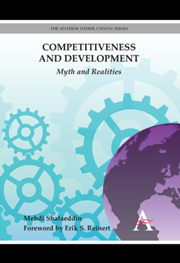Book contents
- Frontmatter
- Contents
- List of Tables, Figures and Boxes
- Foreword
- Preface
- Acknowledgements
- List of Abbreviations
- 1 Introduction: Framework of Analysis
- 2 Context and Conditions of International Competition
- 3 Alternative Theories of Competitiveness
- 4 Firm Strategy and New Industrial Organization
- 5 External Economies: Organization of Interfirm Relations
- 6 Reputation and Trust: A Firm's Relations with Stakeholders and Others
- 7 Innovation and Upgrading
- 8 Government Policies
- 9 The Experiences of China and Mexico
- 10 Summary and Concluding Remarks
- Appendices
- Bibliography
- Index
Preface
Published online by Cambridge University Press: 05 February 2013
- Frontmatter
- Contents
- List of Tables, Figures and Boxes
- Foreword
- Preface
- Acknowledgements
- List of Abbreviations
- 1 Introduction: Framework of Analysis
- 2 Context and Conditions of International Competition
- 3 Alternative Theories of Competitiveness
- 4 Firm Strategy and New Industrial Organization
- 5 External Economies: Organization of Interfirm Relations
- 6 Reputation and Trust: A Firm's Relations with Stakeholders and Others
- 7 Innovation and Upgrading
- 8 Government Policies
- 9 The Experiences of China and Mexico
- 10 Summary and Concluding Remarks
- Appendices
- Bibliography
- Index
Summary
Almost all industrial countries have been concerned with their competitiveness in the international market, particularly during the last quarter century; they have established competitiveness commissions, or councils, in the offices of the presidents, or prime ministers. In all cases they have argued in favour of competitiveness at the high level of development. Government intervention for technological development and upgrading of the industrial structure and services has been their focus of attention. In all cases, they have argued, competitiveness should, in particular, serve the purpose of raising the standard of living of their citizens. The contents of the text of the US Presidential Commission on Industrial Competitiveness (1985, 7) is one example; refuting the narrow approaches to competitiveness based on exchange rate and trade balance, it advocates that competitiveness is the basis for raising a nation's standard of living and the expansion of employment. It should contribute, it is added, to labour productivity, real wage growth, and real return on capital employed in the industry in addition to improving the position of the country in world trade. The Organisation for Economic Co-operation and Development (OECD) Secretariat confirms this approach to competitiveness (OECD 1992, ch. 11). In 2006, the Bush administration approved an extensive policy framework for technological development under the ‘American Competitiveness Initiative’ with a Federal budget of $137 billion covering a wide range of activities. In a speech to the United Nations Economic and Social Council (ECOSOC) in 2007, the US representative clearly defended the need for protection of technology; he stated: ‘…technological change is driven by protection of IPRs [intellectual property rights]’.
- Type
- Chapter
- Information
- Competitiveness and DevelopmentMyth and Realities, pp. xvii - xviiiPublisher: Anthem PressPrint publication year: 2012

